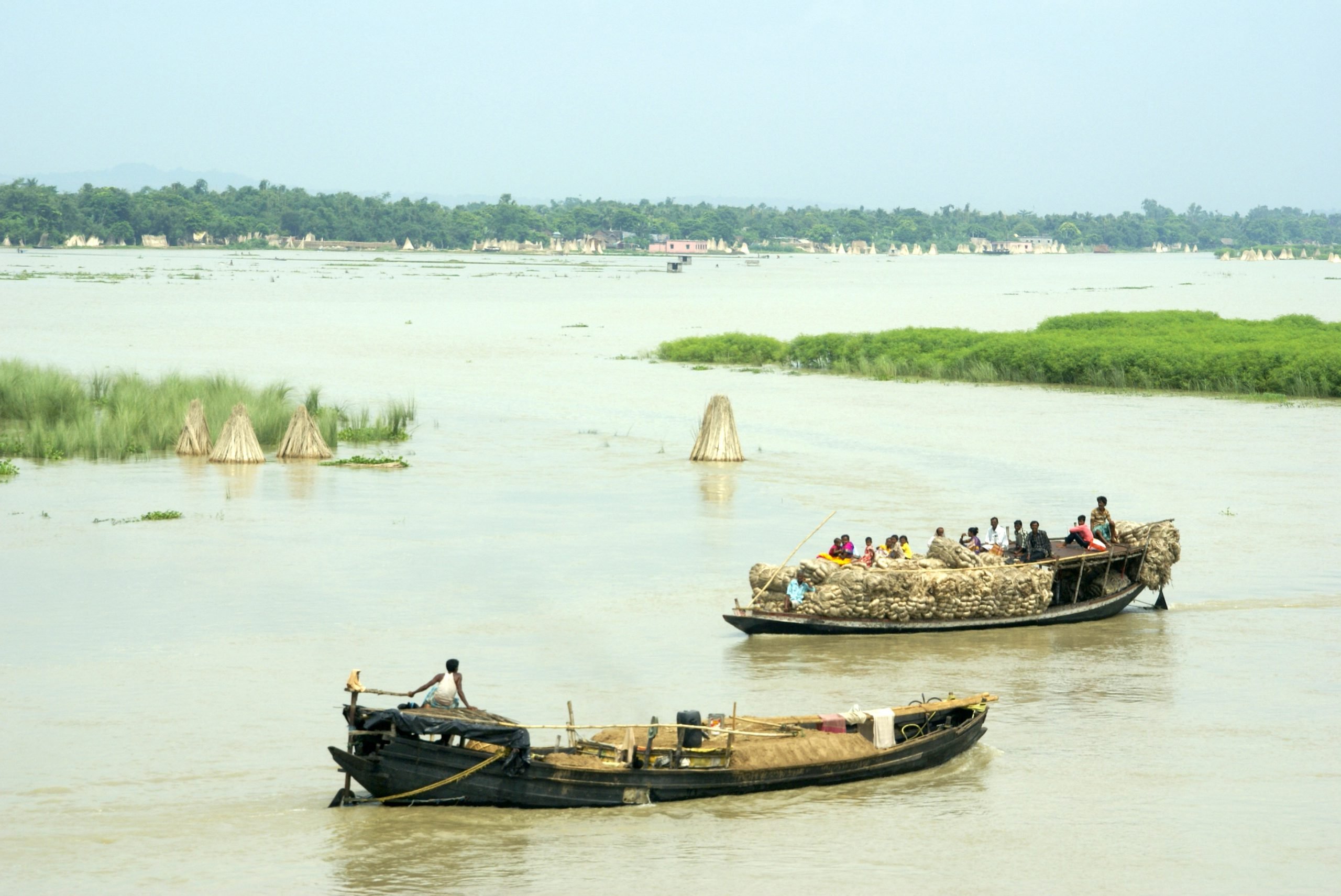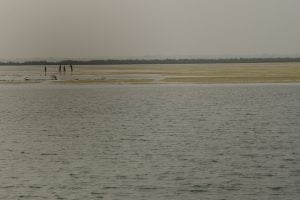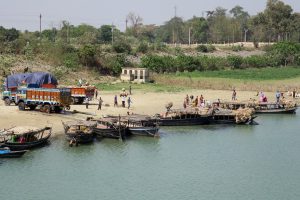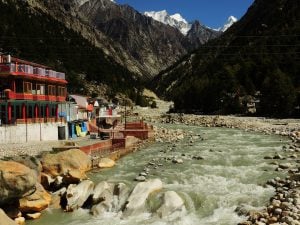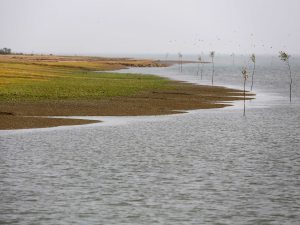The chief minister of the eastern state of Bihar has asked India’s central government to decommission Farakka barrage, saying that it is the “genesis of severe flood consequences and responsible for progressive build-up of silt in the upstream of Ganga between Patna and Bhagalpur”.
In 2016, floods affected over 2.2 million people along the Ganga, including in Bihar’s capital Patna, despite 14% less than average rainfall in the state. This is not an exception. It is officially estimated that the flood-affected area of Bihar has increased from 2.5 million hectares in 1954 to 7.3 million hectares in 2016.
The Farakka barrage is situated on the Ganga in downstream West Bengal, helping allocate water to its two distributaries – the Hooghly river in India and Padma river in Bangladesh – based on a treaty signed by the two countries. The barrage was commissioned in 1975, and is part of a larger river regulation regime in the lower Ganga basin.
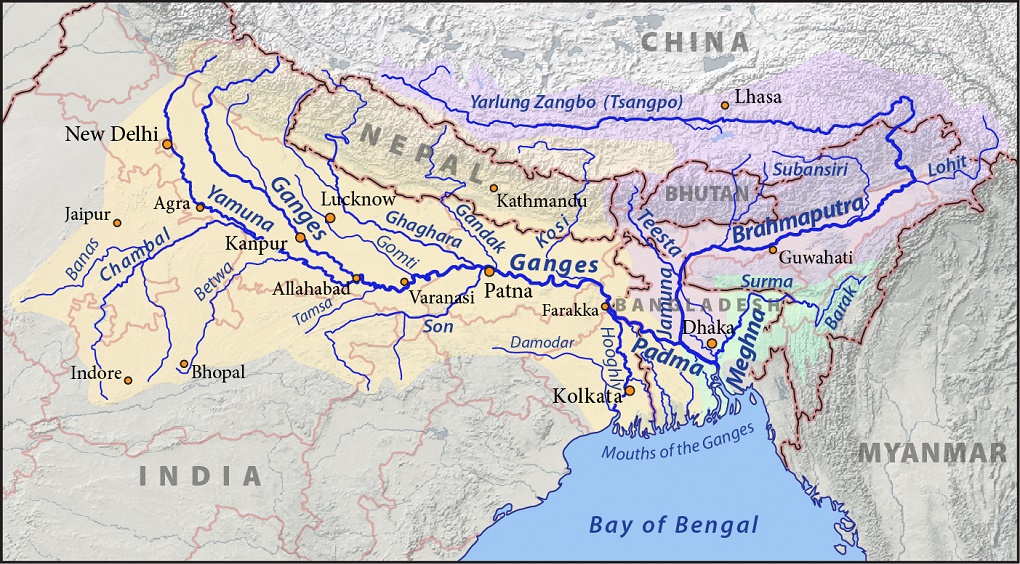
Silt management
Rivers in Asia, particularly the Ganga and the Yellow River in China, carry heavy loads of silt. When authorities think of managing these rivers, they need to retrain their North American- and European-trained minds to see the silt with the water.
Managing Asian rivers is not just about water management but also about silt management. Ignoring this fact is the foundation of the Farakka Barrage problem.
See also Farakka barrage, engineers and hydropolitics
Where do we go from here? Has the Farakka Barrage outlived its utility? It was built to divert freshwater into a drying Hooghly, reduce saline water ingress and sustain shipping to Kolkata port. But the increasing dredging shows Kolkata port is choking again despite the barrage.
Opening the gates of the Farakka Barrage will lead to more water going into the Padma than into the Hooghly. Are we now ready to sacrifice Kolkata port to save Patna from flooding?
Activists and experts do advocate decommissioning the Farakka Barrage, but with caution.
See also Farakka barrage leads to water crisis in Bangladesh
It is in this context that Nitish Kumar’s recent comment gains importance. By targeting silt management, he has started a new paradigm for river management, something that could not only transform the Ganga but also the development of Bihar and Uttar Pradesh and, most importantly, lay the foundations of a truly Asian way of river management.
The Bihar chief minister has urged Prime Minister Narendra Modi to clear obstacles to the river’s flow, a process that would restore the natural flow of silt into the Bay of Bengal, deepen the river channel and increase its water-holding capacity.
Benefits of decommissioning
If the Prime Minister accepts the proposal, it will also fulfil national objectives of the ambitious Namami Gange programme by ensuring both aviral dhara (incessant flow), and thereby nirmal dhara (clean flow). The polluted Ganga would be clean — at least for six months of the year during the monsoon and post-monsoon periods — without even bothering about dysfunctional sewage treatment plants and non-existent sewerage systems. As a bonus, an unfettered Ganga in its lower stretches would be a dramatic boost to the proposed 1,620 km National Waterway 1, reviving trade and commerce in eastern India.
See also Ganga waterways project raises hopes and fears
However, this is a channel-view of the Ganga, one that fails to adequately appreciate the huge seasonal variation in its water flow and associated distribution of silt. During monsoons, the same river will not just flow downstream but also spread laterally, depositing silt in its floodplains. This is the natural process that has created the rich alluvial plains of the Ganga basin, provided wealth to its age-old civilisation, supported legendary kingdoms and attracted foreign interests over centuries.
Problems caused in Bihar
While siltation of the Ganga due to the Farakka Barrage is certainly an issue, there are other factors that have contributed to the flood situation in recent years. Bihar’s leader of opposition, Sushil Modi, blames encroachments on the riverbed and the construction of embankments on the northern tributaries of the Ganga, both points accepted by independent experts gathered at a recent seminar in Patna, organised by Bihar’s Water Resources Department.
Flooding is a natural part of the Ganga basin in Bihar, which sits just a little above the sea level, where land has been created by the silt deposited by its various rivers during annual floods. People traditionally planned for four months of inundation. The current problems have been created because the authorities have turned their backs on this, and most people have started viewing all floods as total disasters.
The main reason for this collective amnesia is the flood protection system that has been built, the ubiquitous dykes and embankments, which not only provide a false sense of security but also create a false boundary between rivers and the societies sustained on their floodplains.
Ironically, while the flood-prone area of the state has increased nearly threefold over the past six decades, the length of embankments created for flood protection has increased over 23 times — from 160 km to 3,731 km between 1954 and 2016.
In the name of protecting people from floodwaters, the authorities have disconnected them from river systems. Natural seasonal floods have been converted to unnatural disasters that now call for emergency measures.
The lost glory of Bihar is actually a story of losing its river water and silt, first under the British when road transport began impeding water flow in the catchment areas, and then under the central and state governments in independent India when embankment construction gained primacy and became visible icons of political patronage.
Short-sighted channelization
The past five decades of Bihar is a story of river channelization, of embankments and a losing fight to contain the waters and silt of North Bihar in artificially defined corridors. As the silt continued to deposit on the riverbeds, the rivers began to rise, leading to an unending cycle of rising waters and higher embankments.
Nitish Kumar wants a national silt policy that will try to find ways of unlocking the value of fertile silt through the spread of this bounty back to the agricultural fields. In September 2016, the central government set up a committee headed by A.K. Sinha, member of Ganga Flood Control Commission, to study silt in the Ganga in Bihar.
Sushil Modi has already demanded the removal of embankments along rivers in north Bihar to revive agriculture productivity of the state. Land and water are state subjects and the chief minister will need to act in the very manner in which he is asking the Prime Minister to act.
Removal of embankments will not only save the drain of state exchequer on costly construction and maintenance of structures, but also unlock the agriculture potential of the state, reviving the growth of this sector dramatically. A robust agriculture sector can lay down the foundations of an industrial and urban growth policy in Bihar, sorely missing today for lack of resources.
